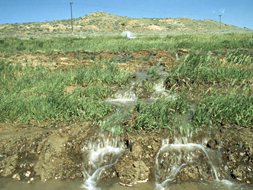Page Content

Why Is Pollution a Challenge?
Increased human activity and development often results in the introduction of exotic and excess materials into a natural system.
What Are Some Examples?

Household sewage & urban waste water: discharge from municipal waste treatment plants, leaking septic systems, untreated sewage, fertilizers and pesticides from law and golf courses, and road salt.
Industrial & military effluents: toxic chemicals from factories, illegal dumping of chemicals, mine tailings, and leakage from fuel tanks.
Agricultural & forestry effluents: nutrient loading from fertilizer runoff, herbicide runoff, manure from feedlots, and soil erosion.
Garbage & solid waste: municipal waste, litter from cars, waste that entangles wildlife, and construction debris.
Air-borne pollutants: acid rain, smog, from vehicle emissions, nitrogen deposition, and smoke from forest fires.
Excess energy: noise from highways and airplanes, heated water from power plants, and lamps attracting insects.
What Are The Effects?
Developed areas are characterized by impervious surfaces, which increase the amount of nutrient, chemical and sediment runoff.
Industrial activities, especially those that require large amounts of water, release nutrients, chemicals and sediments into nearby water systems.
Herbicides and pesticides applied to both cropland and forested areas can make their way into local water systems.
Air-borne pollutants can be deposited into an ecosystem through contaminated rain, snow, fog, dust and gases.
Some species of bats can eat up to 100,000 insects a night. However, these insects are oftentimes loaded with the herbicides and pesticides applied to cropland. Through the process of bioaccumulation, these toxic chemicals can build up in the bat’s system with fatal results.
What Are Some Of The Things CPW Is Doing?
 The
State Water Quality Control Commission is responsible for decisions regarding how much pollution is acceptable in Colorado’s waters. Prior to the 1989 formation of CPW’S
River Watch, they had no baseline data at all! Volunteers, covering all the watersheds in Colorado, collect water quality data used to inform this commission’s important work in ensuring only the highest-quality water flows through Colorado’s rivers, lakes and streams.
The
State Water Quality Control Commission is responsible for decisions regarding how much pollution is acceptable in Colorado’s waters. Prior to the 1989 formation of CPW’S
River Watch, they had no baseline data at all! Volunteers, covering all the watersheds in Colorado, collect water quality data used to inform this commission’s important work in ensuring only the highest-quality water flows through Colorado’s rivers, lakes and streams.
Colorado’s big cities, as exciting as they may be, create light pollution which disturbs both human sleep cycles and animal life cycles. CPW’s
Resource Stewardship Team is currently studying the effects of dark skies in state parks, and has some exciting programs in the works.

